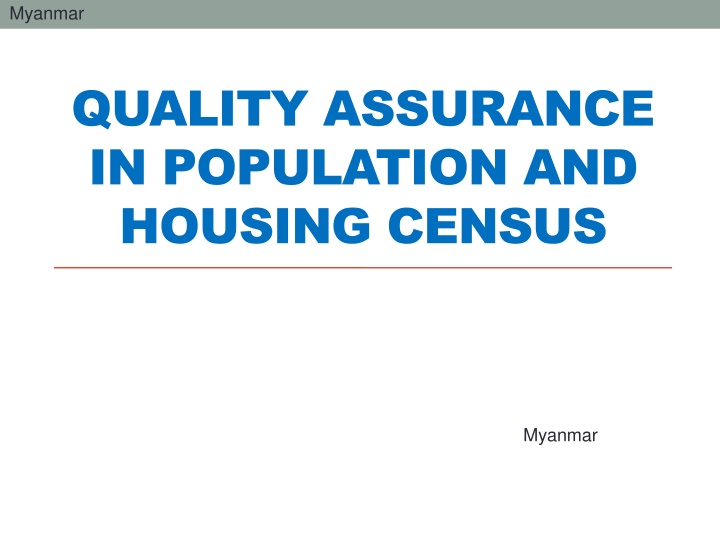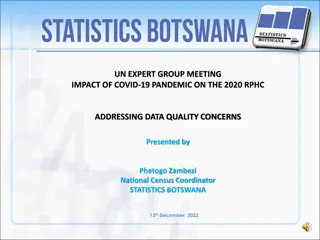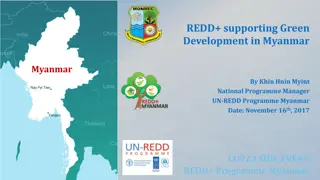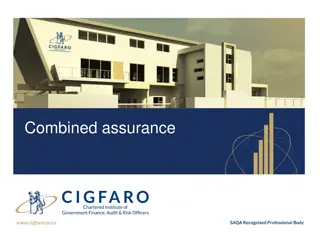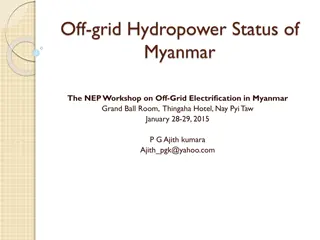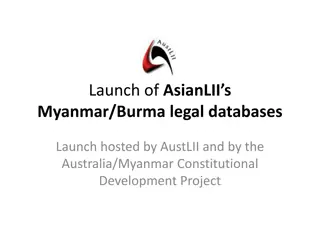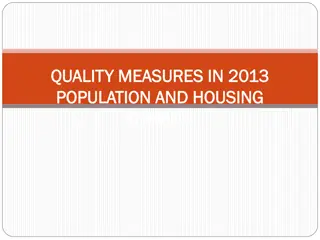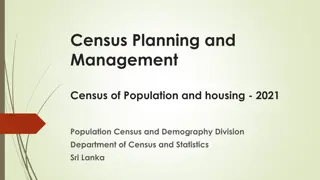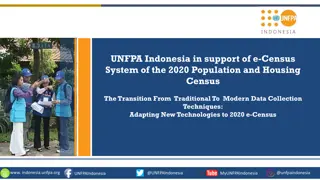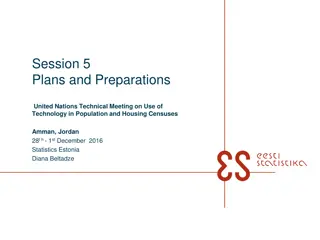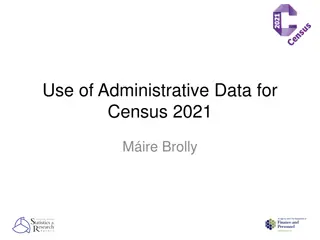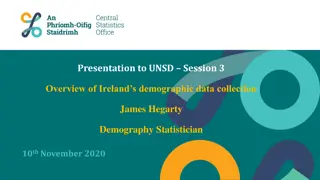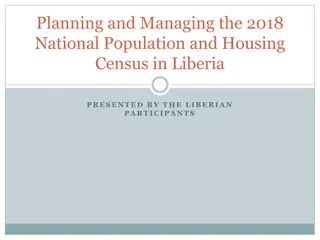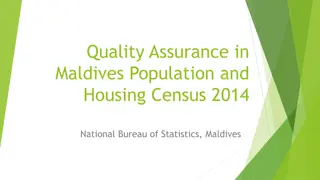Myanmar Population and Housing Census Quality Assurance
Myanmar conducts a census every 10 years to gather accurate and reliable data for decision-making. The process includes planning, management, field operations, data processing, analysis, and dissemination. Various activities such as consultation, training, and monitoring are carried out to ensure the success of the census and the completeness of household counting. International technical assistance and meticulous preparation work contribute to the quality assurance of the population and housing census in Myanmar.
Download Presentation

Please find below an Image/Link to download the presentation.
The content on the website is provided AS IS for your information and personal use only. It may not be sold, licensed, or shared on other websites without obtaining consent from the author.If you encounter any issues during the download, it is possible that the publisher has removed the file from their server.
You are allowed to download the files provided on this website for personal or commercial use, subject to the condition that they are used lawfully. All files are the property of their respective owners.
The content on the website is provided AS IS for your information and personal use only. It may not be sold, licensed, or shared on other websites without obtaining consent from the author.
E N D
Presentation Transcript
Myanmar QUALITY ASSURANCE IN POPULATION AND HOUSING CENSUS Myanmar
Myanmar 2 Outline Outline Quality assurance (a) Planning (b) Management and Preparatory work (c) Field operations (d) Data processing (e) Census Analysis and Dissemination
Myanmar Planning Census conduct in every 10 years In Myanmar no census between 1983 census and 2014 census (period of 30 years) Most of the population information/data has relied on: Projections/estimates Surveys Political and economic reforms since 2011 inevitable need for accurate, up-to-date and reliable data for decision making
Myanmar Census Planning Enumeration: Preliminary results: August 2014 Final results: May 2015 30th March 10th April 2014 (pilot census April 2013 )
Myanmar International Technical Assistance Chief Technical Adviser (CTA) Consultants: Cartography/Mapping Communication and Publicity Campaign Questionnaire design Data capture and processing Data analysis
Myanmar Management and Preparatory work Preparatory activities Preparation of project document Setting up of various committees and structures EA Mapping Questionnaire Training Materials Recruitment of field personnel Publicity/Advocacy
Myanmar Field operations To ensure complete coverage in the enumeration period To monitor progress and quality control, Enumerators and Supervisors were provided with sets of control forms, including: Daily progress forms EA summary sheets (to be used for provisional results) Completion forms Observation Mission Organize at the invitation of Government, with the aim of enhancing transparency of the census process and to receive regular feedback from the field
Myanmar Making sure all households were counted Enumerators worked in the localities they reside in and know. Good maps and lists of structures were produced beforehand. Enumerators submitted daily progress reports on households counted.
Myanmar Verifying the data collected Before leaving each household, enumerators made sure all questions were answered and recorded. Random re-Interviews were conducted for at least three households in every EA. EA Summary sheets completed by enumerators listed all the households where they conducted interviews. Township Committee supervision ensured that all EAs were accounted for.
Myanmar Post-enumeration activities Securely delivering questionnaires to the Census Office Safely storing and organizing the questionnaires Rigour in the receiving process Preparing questionnaires for scanning Registration before scanning High-tech scanning process Computerised character inspection and Key corrections Monitoring and supervision Addressing data inconsistencies Protecting the data
Myanmar Securely delivering questionnaires to the Census Office Transportation of all census materials was done by professional transport companies. Security officers accompanied each shipment.
Myanmar Safely storing and organizing the questionnaires Storage area holds an estimated 11 million completed questionnaires. Cataloguing of questionnaires by location allows for ease of retrieval.
Myanmar Rigour in the receiving process Countof questionnaires received and completed was verified by Township Census Officers. Completeness was confirmed and explanations provided for any missing EAs or households.
Myanmar Preparing questionnaires for scanning EA codeswere checked. Questionnaires were checked for damage, staples and clips were removed, and the forms were then split in two along a perforated line. Registration forms detailed the number of questionnaires to be scanned for each EA
Myanmar Registration before scanning Information from the pre-scanning process was further checked for discrepancies and then entered into a database containing all the EA codes This information is linked to the scanning system, so the scanner can tell if there is a difference between the number of questionnaires received and scanned.
Myanmar High-tech scanning process Eight state-of-the-art scanners working simultaneously can read around 150,000 questionnaires a day, reject any damaged forms and identify character anomalies.
Myanmar Computerised character inspection Scanners detect unreadable or possibly erroneous characters on the forms and automatically send them to the Key Corrections team for further processing.
Myanmar Key corrections Operators check the highlighted numbers on each questionnaire and make necessary corrections. An operator clicks on the unrecognised number to enlarge it and see what it should be. If unsure about the correction, the operator sends the case to the supervisor. The scanning software captures the number of cases corrected as well as who made the correction. Corrections can only be made on numbers highlighted by the system and not on any other data.
Myanmar Monitoring and supervision The scanning system enables managers to track progress, (for example, by showing how many forms have been scanned or how many characters have been inspected at any given time.) This allows them to verify that staff are performing their jobs skillfully, as well as to reallocate staff as needed, for instance to address a backlog that is slowing the data capture process.
Myanmar Addressing data inconsistencies In some instances, information collected in the field may seem illogical or not be consistent with common sense. This happens in all censuses, both in developed and developing countries. (For example, a 5-year-old child may be recorded as having completed secondary education, or a 6-year - old as having given birth to two children. )
Myanmar Protecting the data The Census Office is using state-of-the-art computer technology to make certain that all census data is stored safely and efficiently. All census data is backed up locally and remotely every day.
Myanmar Census Analysis and Dissemination Census dataset was cleaned before release of Main results Data file available in CSPro, SPSS and REDATAM software National and State/Region Launch Dissemination workshops have been done in all districts across the country Township Dissemination workshops is on going process
Myanmar Conclusion Collecting, verifying and analysing data through Myanmar s population census is an enormous and time consuming undertaking involving numerous distinct steps. Quality assurance at each stage is a key component of the process, and essential to ensuring the data s overall reliability. Access to accurate and reliable population data is essential as the country formulates its development policies and projects to improve the lives of all its people. All the census reports were distributed through www.dop.gov.mm or http://myanmar.unfpa.org/ census
Myanmar Thank You
